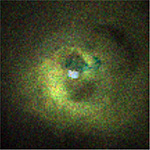June 7, 2000
CXC PR: 00-18
NASA's Chandra X-ray Observatory image of Perseus A provides new insight into how this supergiant galaxy has grown by cannibalizing other galaxies and gas in the vicinity. For the first time astronomers see an X-ray shadow cast by a smaller galaxy as its gas is being stripped away by the enormous galaxy.
The research was reported by Professor Andrew Fabian of the Institute of Astronomy, Cambridge, England on June 7 at the 196th National Meeting of the American Astronomical Society, in Rochester, NY. Other members of the research team are Jeremy Sanders, Stefano Ettori, Steve Allen, Carolin Crawford, Kazushi Iwasawa, and Roderick Johnstone of the Institute of Astronomy, Gregory Taylor on the National Radio Astronomy Observatory, Socorro, NM, and Patrick Ogle of the Massachusetts Institute of Technology, Cambridge, MA.
Perseus A, or NGC 1275, is in the center of a large galaxy cluster 320 million light years from Earth. The cluster, which contains thousands of galaxies and enough gas to make thousands more, is one of the largest gravitationally bound objects in the universe. Over the eons, Perseus A has accumulated hundreds of billions of stars to become one of the most massive known galaxies as gas and galaxies have been pulled inward by gravity.
The Chandra observation shows a region of hot gas that extends over several hundred thousand light years. The gas in the outer portion of the cluster has a temperature of 70 million degrees. The cluster gas cools gradually and settles toward the center of the cluster. A galaxy with "only" about 20 billion stars is falling into Perseus A (located at two o'clock from the center of the image) and appears as a small dark patch due to absorption of X rays by cool gas in the infalling galaxy.
Another larger hole seen further out is thought to be due to a bubble of high-energy particles ejected in an explosion from Perseus A hundreds of millions of years ago. These outbursts are presumably fueled by matter releasing tremendous quantities of energy as it falls into a giant black hole in the center of the galaxy.
Closer in, the effects of a more recent explosion show up as dark twin cavities, each large enough to contain a galaxy half the diameter of our Milky Way galaxy. These cavities, which have been detected at lower resolution by previous X-ray satellites, appear to be buoyant, magnetized bubbles of energetic particles. The Chandra image shows that the gas that has piled up in the brilliant rims has "cooled" to a temperature of 30 million degrees. A long spiral of hot gas appears to be winding inward around the cavities toward the center of the galaxy. Fabian and his colleagues propose that the cooling of gas in this spiral can lead to the formation of a spiral structure of stars that has been detected in optical images of the galaxy.
The observation was made on January 29, 2000 for 6.8 hours using the Advanced CCD Imaging Spectrometer (ACIS).
The Advanced CCD X-ray Spectrometer (ACIS) X-ray camera was developed for NASA by Penn State University, University Park, and the Massachusetts Institute of Technology, Cambridge. NASA's Marshall Space Flight Center in Huntsville, Alabama, manages the Chandra program. TRW, Inc., Redondo Beach, California, is the prime contractor for the spacecraft. The Smithsonian's Chandra X-ray Center controls science and flight operations from Cambridge, Massachusetts.
Images associated with this release are available on the World Wide Web at
MEDIA CONTACTS
Steve Roy
Marshall Space Flight Center, Huntsville, AL
Phone: 256-544-6535
Dr. Wallace Tucker
Chandra X-ray Observatory Center, CfA, Cambridge, MA
Phone: 617-496-7998



